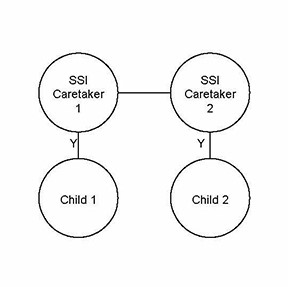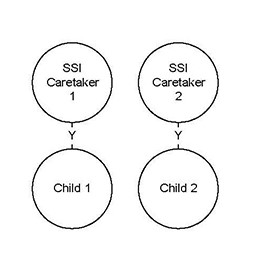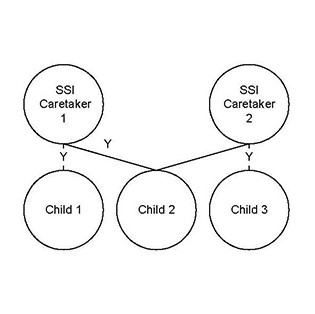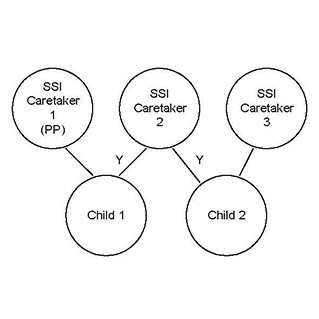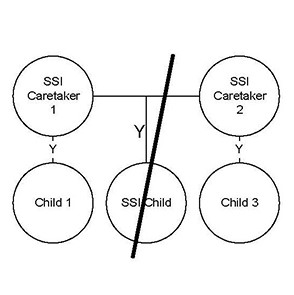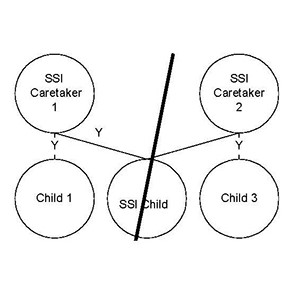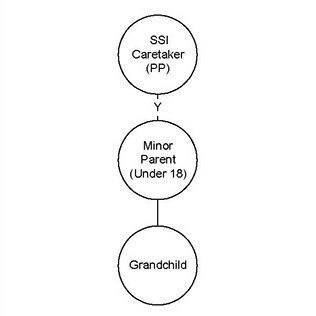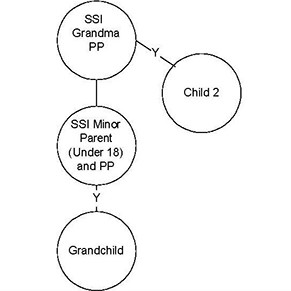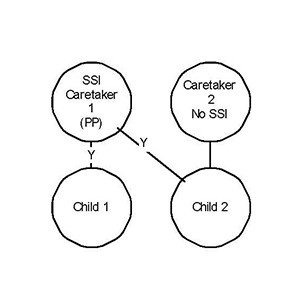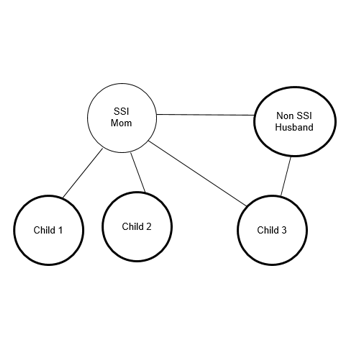22-02 Version of 5.4 Illustrations
5.4.1 Scenarios
| Scenario 1 | |
|
|
Mom and Dad are married but do not have any children in common. Explanation Without a child in common, CARES cannot create a "link" to pull Child 1 and Child 2 into the same SFU. Because the parents are married, CARES can process this situation in one case. CARES Processing CARES will create two CTS AGs in one case. CTS Benefits There will be two CTS supplements in the amount of $250 each. |
| Scenario 2 | |
|
|
Two SSI caretakers are living together in one household. They are not married and do not have any children in common. Explanation Without a child in common, CARES cannot create a "link" to pull Child 1 and Child 2 into the same SFU. Because the parents are not married, CARES cannot process this situation in one case. CARES Processing This household must be processed in two cases. CTS Benefits There will be two CTS supplements in the amount of $250 each. |
| Scenario 3 | |
|
|
The parents in this household are not married. They have at least one child in common. One of the parents has their own child(ren). Explanation The oldest child in common is the target child. The child in common provides a link for their siblings to be pulled into the SFU. CARES Processing Parents should be coded on ANHR as caring for all of their children. Because Caretaker 1 is the parent for both Child 1 and Child 2, that parent is coded as caring for both children on ANHR. This will produce one AG in CARES. CTS Benefits The CTS supplement will be $400, paid to Caretaker 1. |
| Scenario 4 | |
|
|
The parents in this household are not married. THey have at least one child in common and each has their own child(ren). Explanation The child in common provides a link to their siblings to be pulled into the SFU. CARES Processing Because everyone is pulled into one SFU, this scenario will be processed in one AG. Because Caretaker 1 has no qualifying relationship to care for Child 3, Child 3 cannot be included in their CTS supplemental payment. CTS Benefits A CTS Supplement will be added to each parent's state SSI payment. Caretaker 1 will receive a $400 payment; Caretaker 2 will receive a $250 supplement. |
| Scenario 5 | |
|
|
Mom and Dad are married. They have at least one child in common and each has their own child(ren). Explanation The child in common provides a link to their siblings to be pulled into the SFU. CARES Processing Because each SSI caretaker is caring for their own child, there will be two AGs for this case, just like Scenario 4. CTS Benefits A CTS supplement will be added to each parent's SSI payment. Caretaker 1 will receive a $400 payment; Caretaker 2 will receive a $250 supplement. |
| Scenario 6 | |
|
|
There are more than two parents in the household, all of which have children, and more than one in common with another parent. Explanation In this scenario, the target child will be the oldest child in common and will pull all of their siblings. Pulling in those siblings will also pull in their parents. CARES Processing This particular scenario will be one SFU and one AG (everyone is pulled into the group). In this scenario, it is important to analyze which parent has the most children in the household; who is the primary caretaker of the majority of the children. That parent (in this diagram, Caretaker 2) should be coded as caring for all their children on ANHR. CTS Benefits This case will be paid one CTS supplement to Caretaker 2 in the amount of $400. |
| Scenario 7 | |
|
|
Mom and Dad are married. They have a child in common and a child(ren) of their own. The only child in common is an SSI recipient. Explanation The SSI child breaks the link between Child 1 and Child 3. No relationship exists between Child 1 and Child 3 (they are not full or half siblings) to pull the children into one SFU. CARES Processing Because the parents are married, this scenario can be processed in one case, two AGs. CTS Benefits This case will receive two CTS payments of $250 each. |
| Scenario 8 | |
|
|
Mom and Dad are not married. They have a child in common and a child(ren) of their own. The only child in common is an SSI recipient. Explanation The SSI child breaks the link between Child 1 and Child 3. No relationship exists between Child 1 and Child 3 (they are not full or half siblings) to pull the children into one SFU. CARES Processing Because the parents are not married, this scenario cannot be process in one case. It must be processed in two separate cases. CTS Benefits Each case will receive one CTS payment of $250. |
| Scenario 9 | |
|
|
Three-generation case. Grandma is receiving SSI; the minor parent is not. Grandma is requesting CTS. Explanation The minor parent is the target child, the grandchild is not pulled into the SFU. CARES Processing Grandma should be coded as caring for the minor parent. Even if she's coded as caring for the grandchild, the grandchild will not be pulled into the CTS SFU. Grandma cannot receive CTS for her grandchild. CTS Benefits The CTS benefit will be added to Grandma's SSI state check in the amount of $250. |
| Scenario 10 | |
|
|
Three-generation case. Grandma is not receiving SSI; the minor parent is. The minor parent is requesting CTS. Explanation The grandchild is the target child. The minor parent and grandchild will comprise the SFU. CARES Processing The minor parent must be coded as caring for the grandchild. CTS Benefits The CTS benefit will be added to the minor parent's SSI state check in the amount of $250. |
| Scenario 11 | |
|
|
Three-generation case. Both Grandma and the SSI child are receiving SSI. Explanation The SSI minor parent cannot be pulled into Grandma's SFU. The household cannot be processed in one case. It must be two separate cases. CARES Processing Grandma should be coded as caring for her non-SSI child in her case. The minor parent should be coded as caring for their child in their case. CTS Benefits Each case will be paid a CTS benefit of $250. |
| Scenario 12 | |
|
|
The parents in this household are not married. They have at least one child in common. One of the parents has their own child(ren). Explanation The oldest child in common is the target child. The child in common provides a link for their siblings to be pulled into the SFU. CARES Processing Parents should be coded on ANHR as caring for all of their children. Because Caretaker 1 is the parent for both Child 1 and Child 2, that parent is coded as caring for both children on ANHR. This will produce one AG in CARES. CTS Benefits The CTS supplement will be $250, paid to Caretaker 1. (Child 2 is ineligible because only one of their parents is an SSI recipient.) Buening Implications This case has the potential of becoming a Buening case. If the group fails the CTS eligibility test for financial reasons, the worker must determine whether Child 2 is "needy." If Child 2 is needy, the group should be confirmed as ineligible for CTS. If Child 2 is not needy, the worker must change the request on ACPA to "N" for both Child 2 and SSI Caretaker 2 and retest the group for CTS eligibility. |
| Scenario 13 | |
|
|
The parents in this household are married. They have one child in common. The mom has two of her own children under age 18. None of the children have any income of their own. Explanation All three dependent children of the SSI Mom and non-SSI Dad of Child 3 are initially included in the Standard Filing Unit (SFU). The income and assets of all four members of the SFU are used to determine financial eligibility for CTS.
Buening Implications This household may also end up as a Buening case. If the assets are over the limit of the income for the SFU exceeds the gross or net income limit for the group of four, the worker must determine whether Dad and Child 3 are "needy." If the dad and Child 3's income exceeds the gross or net income limit for Dad and Child 3, Child 3 is not needy and should be excluded along with their dad from the SFU. CTS Benefits If it is determined to be a Buening case and Child 3 is not considered needy, Child 3 and Dad should be excluded from the SFU. If the income and assets of Child 1 and 2 are at or below the limits for an SFU group of two, they will be eligible for a CTS supplement of $400, paid to the SSI Mom. Child 3 is ineligible because only one of their parents is an SSI recipient. |
This page last updated in Release Number: 22-02
Release Date: 08/01/2022
Effective Date: 08/01/2022
